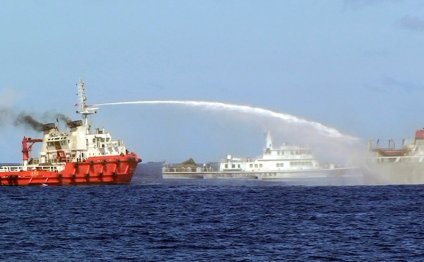
South Philippines
The next stage in the Philippines’ closely-watched arbitration case against China’s maritime claims will come in March when Manila’s lawyers submit their answers to questions posed last month by the five judge panel overseeing the case. The Philippines has put together a clever case, one that seeks to skirt China’s exemptions to compulsory arbitration as allowed by the United Nations Convention on the Law of the Sea (UNCLOS). But the case is not a slam dunk, and that might be for the best.
The heart of the Philippines’ case is an argument that China’s infamous nine-dash line does not qualify as a valid maritime claim. If the Arbitral Tribunal finds that it has jurisdiction in any part of the case, it is hard to imagine that it will not agree with Manila on this point. And that ruling—that Beijing is legally obligated to lay out its claims based on maritime entitlements from coastlines and islands, not via dashes arbitrarily drawn on a map—could be enormously beneficial for all those with an interest in the South China Sea.
Despite Beijing’s insistence that it will not recognize any award the court makes, China’s leaders might be persuaded to clarify the country’s South China Sea claims even while publicly refusing to obey the court. This would be much the same as how the United States under the Clinton administration complied with much of an International Court of Justice ruling in a case brought by Nicaragua that the Reagan administration had earlier rebuffed.
(Recommended: )
Chinese legal experts both inside and outside government already know that Beijing will eventually need to redefine the nine-dash line. In theory, it could maintain a claim to most of the waters within the line by making (admittedly extreme) EEZ and continental shelf claims from the Paracel and Spratly Islands. That is a clarification that the Chinese leadership could live with.
Other parts of the Philippines’ case are more ambitious, more tenuous, and less acceptable to China. Manila has asked the Tribunal to rule that several features occupied by China are in fact low-tide elevations, not islands, and are therefore not open to claims of sovereignty because they are legally part of the seabed. At least one of these features listed by the Philippines appears to lie within the territorial sea of a rock or island claimed by China and is therefore beyond the possible jurisdiction of the court. The court may or may not find it has sufficient evidence to rule on the remaining features, especially because accurate surveys of the Spratlys are notoriously lacking. If the tribunal does rule these features to be low-tide elevations and orders China to evacuate them, it is hard to imagine that Beijing will comply.
See also:
- get today mines play for real money
RELATED VIDEO



Share this Post
Related posts
Where to Go in Cebu Philippines?
Cebu, Philippines is the 2009 fourth best island destination in Asia based on Condé Nast Traveler Magazine. A consistent…
Read MoreManila tourist Guide
Manila is chaotic, polluted and thrilling; an old city but one overflowing with life, which is steadily increasing in popularity…
Read More
 South Korea ( listen), officially the Republic of Korea (Hangul: 대한민국; Hanja: 大韓民國; Daehan Minguk listen), is a sovereign state in the southern part of the Korean Peninsula. The name "Korea" is derived from Goryeo, a dynasty which ruled in the Middle Ages (an...
South Korea ( listen), officially the Republic of Korea (Hangul: 대한민국; Hanja: 大韓民國; Daehan Minguk listen), is a sovereign state in the southern part of the Korean Peninsula. The name "Korea" is derived from Goryeo, a dynasty which ruled in the Middle Ages (an...
 The South West Pacific Theatre, technically the South West Pacific Area, between 1942 and 1945, was one of two designated area commands and war theatres enumerated by the Combined Chiefs of Staff (CCoS) of World War II in the Pacific region.
The South West Pacific Theatre, technically the South West Pacific Area, between 1942 and 1945, was one of two designated area commands and war theatres enumerated by the Combined Chiefs of Staff (CCoS) of World War II in the Pacific region.









